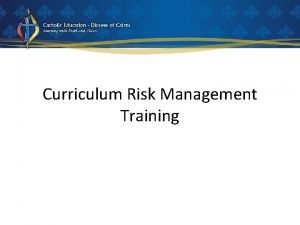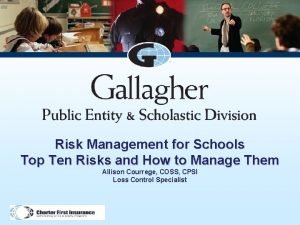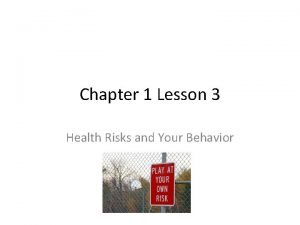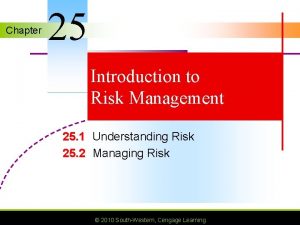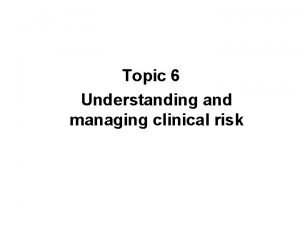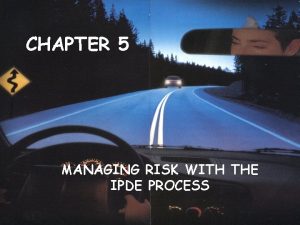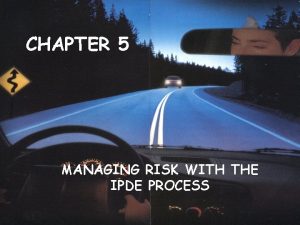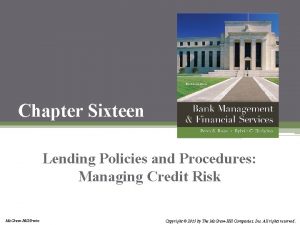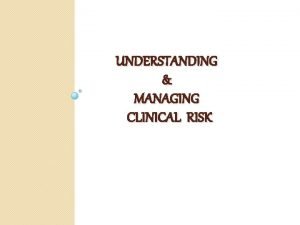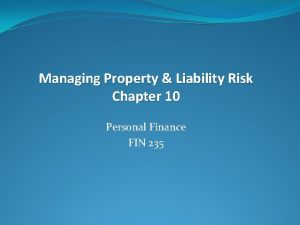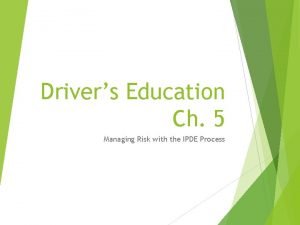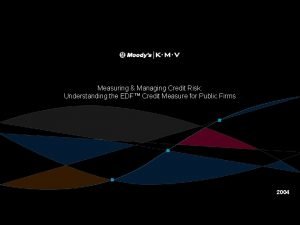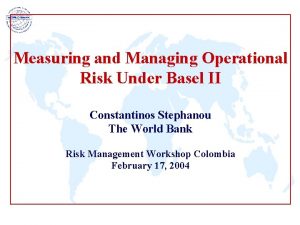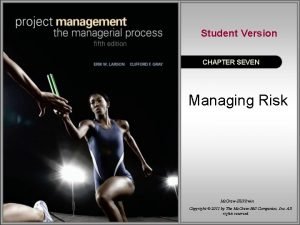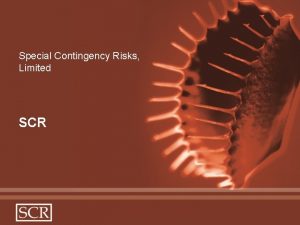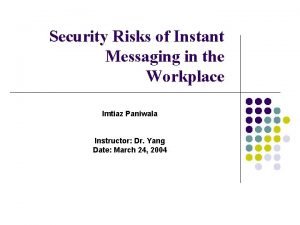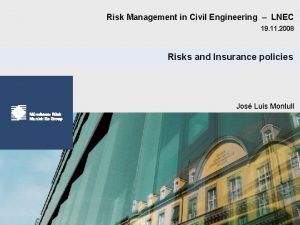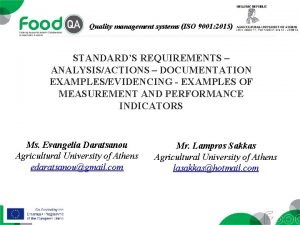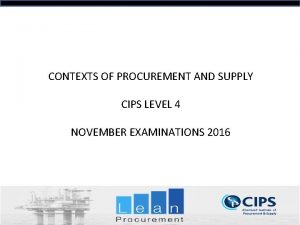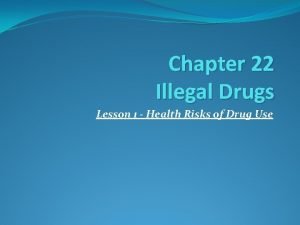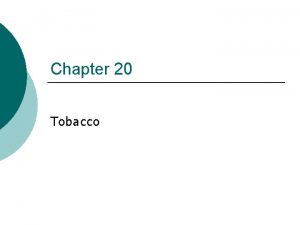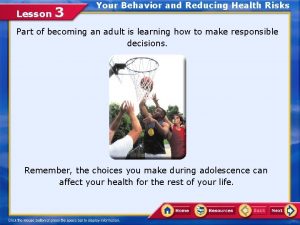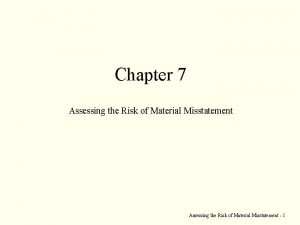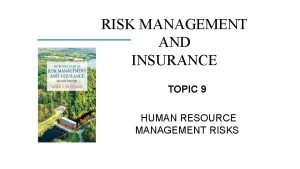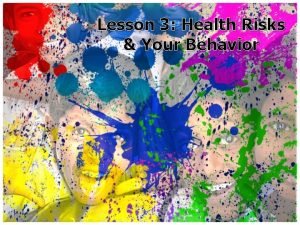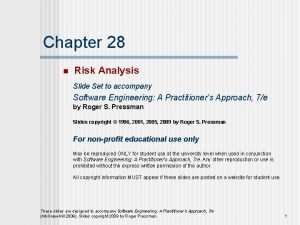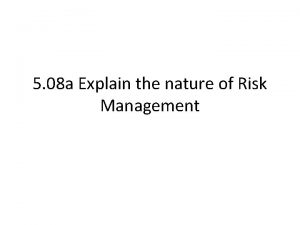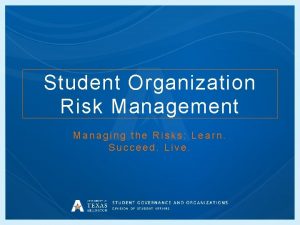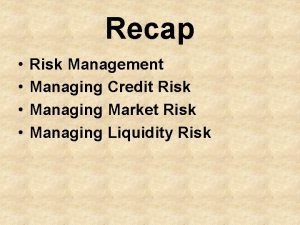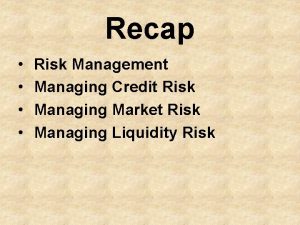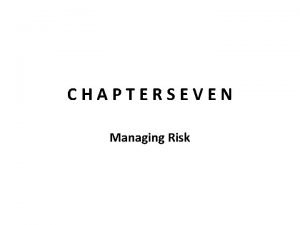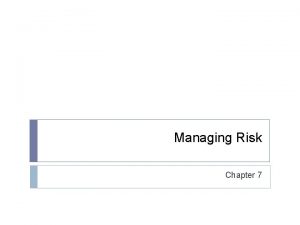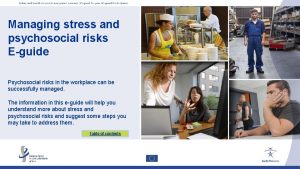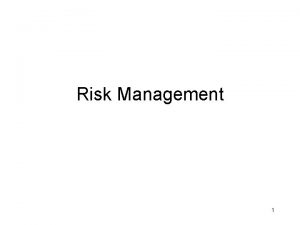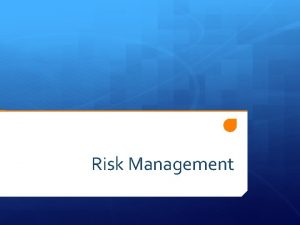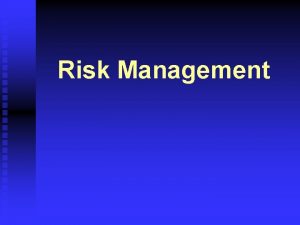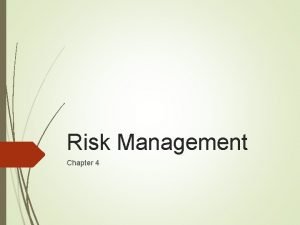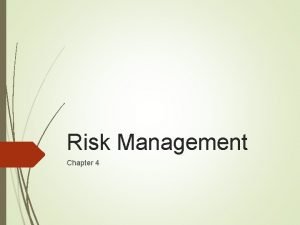Student Organization Risk Management MANAGING RISKS WHAT YOU












































![Sexual Abuse-Sexual Harassment is “unwelcome conduct of a sexual nature…[and]…can include unwelcome sexual advances, Sexual Abuse-Sexual Harassment is “unwelcome conduct of a sexual nature…[and]…can include unwelcome sexual advances,](https://slidetodoc.com/presentation_image_h/87f947412fcaf00bd8329a5b37081f3f/image-45.jpg)






































- Slides: 83

Student Organization Risk Management MANAGING RISKS: WHAT YOU NEED TO KNOW TO STAY SAFE

RISK MANAGEMENT As a representative of your student organization, you are responsible for sharing this information to your organization. A copy of this powerpoint will be available on Jag. Sync.

Why? It’s the law State law requires student organizations to complete a risk management training in order to be considered a registered student organization To promote a safe and positive experience Risk Management is the process of considering the potential and perceived risk involved in student activities. It includes monitoring organization activities and taking both corrective action and proactive steps to minimize accidental injury and/or loss.

Legislation HB 2639/SB 1138 –effective September 1, 2007 Clay R. Warren Bill 80 th. Texas Legislature; Texas Education Code 51. 9361 Mandates risk management education for members and advisors of student organizations registered at postsecondary education institutions.

What Will I Learn From The Training? Ability to define risk management Use the risk matrix to identify and manage risk Identify risk in activities planned by an organization Develop methods to manage risk in activities planned by organization

Risk Management Concepts and Tools

High Risk Activities Alcohol and Illegal Drugs Hazing Sexual Abuse and Harassment Fire and Other Safety Issues Travel Behavior at Parties and Social Events Others?

8 5 Risk Types Physical - Bodily injuries that occur from participation in an activity • Obvious risks such as rope climbing • Less obvious such as food-borne illnesses from a picnic • Other: injury, illness, death, hazing, sexual assault, high-risk, excessive drinking Reputation - Incidents that may lead to defamation or portray a bad image of the individual officers and members present, the reputation of the student organization, and the reputation of the university as a whole. • The media, alumni, family, donors, views from other members of the community Emotional – Incidents that alienate or harm the feelings of members of the community • Selecting a theme for your event that stereotypes/offends a particular group • Psychological, hazing, sexual assault, eating disorders, alcohol and drug abuse

9 5 Risk Types Financial - Occurrences that negatively impact the fiscal stability of the organization • Paying for damages incurred by a band you booked to play on campus • Theft or misuse of funds due to poor accounting, money handling, fundraising, budgets, or financial oversight Facilities - include both the safety of the facilities used for your members/participants and the maintenance of the facilities used by your members/participants. • Fire safety, property damage, exceeding room capacity, crowd control, driving, weather • Reserving a space that is too small for the number of participants that show up

1 0 Risk Management Concepts Identify risky behavior and activities Assess the probability of adverse outcomes Identify and implement controls to eliminate or reduce the risk Reassess the activity after the risks have been managed Georgia Institute of Technology, 2002

1 1 Risk Management and Insurance Matrix

1 2

1 3 Sample University Sample Event Sample University Outdoors is a fun, free event where children are taught about wildlife, plants, and the outdoors. Events include safety in archery and shooting, plant identification, arts and crafts, fish printing, ducks unlimited, mystery boxes, fire trucks, Smokey the Bear, birds of prey display, state park information, casting lessons, and many more booths. Gates open at 9 am and close at 3 pm. Children and parents are free to come any time during these hours. A free hotdog lunch is provided, along with drinks and chips.

1 4 Step One: List all risk concerns for Sample University Outdoors

NAME OF EVENT: Outdoor Event LIST SPECIAL ACTIVITIES ASSOCIATED RISKS* SERIOUSNESS PROBABILITY METHOD TO MANAGE RISKS** 1. BB Gun Shooting 1. 1. 2. Climbing Wall 2. 2. 3. Archery 3. 3. 4. ATV’s 4. 4. * Possible risks include: medical emergencies, food poisoning/allergic reactions, damage to University reputation, damage to University property and/or facilities, accidents, injury, and/or de **Methods to manage risks may include: purchasing special event liability insurance, arranging for security through TSU PD, traveling with an advisor, rotating drivers, etc. SERIOUSNESS OF RISK I – May result in death. II – May cause severe injury, major property damage, significant financial loss, and/or result in negative publicity for the organization and/or institution. III – May cause minor injury, illness, property damage, financial loss, and/or could result in negative publicity for the organization and/or institution. PROBABILITY Probability Seriousness I II IV A B C D A – Likely to occur immediately or in a short period of time, expected to occur frequently. B – Probably will come in time C – May occur in time. D – Unlikely to occur. IV – Hazard presents a minimal threat to safety, If any special activity score is within the red or yellow the Office of Student Activities must review. The Risk Management & Insurance Matrix must be filed when an Activity health, and well-being of participants. Proposal is require. The form has been provided as an educational tool to help student leaders to develop a process for identifying and discussing potential risk issues. It is intended for use as part of a larger event planning process, and should only serve as a starting point for your discussion on risk management. It is not designed to take the place of a careful review of applicable rules, policies, and laws, or discussion with your advisor. Completion of this form does not imply approval or authorization of your event by Tarleton State University. For more information on event planning, contact Student Activities in the Thompson Student Center.

1 6 Step Two: Identify risk associated with each activity

1 7 Step Two Identification of Risk Driving • ATV’s • Other Vehicles Events • BB Gun Shooting • Climbing Wall • Archery Physical Risks • Insect Bites • Slips, Trips, Falls • Animal Concerns Financial • Liability • Insurance Reputation • What If ? ? ?

NAME OF EVENT: Outdoor Event LIST SPECIAL ACTIVITIES ASSOCIATED RISKS* SERIOUSNESS PROBABILITY METHOD TO MANAGE RISKS** 1. BB Gun Shooting 1. Accident Injury 1. 1. 2. Climbing Wall 2. Accident Injury 2. 2. 3. Archery 3. Accident Injury 3. 3. 4. ATV’s 4. Accident Injury 4. 4. * Possible risks include: medical emergencies, food poisoning/allergic reactions, damage to University reputation, damage to University property and/or facilities, accidents, injury, and/or de **Methods to manage risks may include: purchasing special event liability insurance, arranging for security through TSU PD, traveling with an advisor, rotating drivers, etc. SERIOUSNESS OF RISK I – May result in death. II – May cause severe injury, major property damage, significant financial loss, and/or result in negative publicity for the organization and/or institution. III – May cause minor injury, illness, property damage, financial loss, and/or could result in negative publicity for the organization and/or institution. PROBABILITY Probability Seriousness I II IV A B C D A – Likely to occur immediately or in a short period of time, expected to occur frequently. B – Probably will come in time C – May occur in time. D – Unlikely to occur. IV – Hazard presents a minimal threat to safety, If any special activity score is within the red or yellow the Office of Student Activities must review. The Risk Management & Insurance Matrix must be filed when an Activity health, and well-being of participants. Proposal is require. The form has been provided as an educational tool to help student leaders to develop a process for identifying and discussing potential risk issues. It is intended for use as part of a larger event planning process, and should only serve as a starting point for your discussion on risk management. It is not designed to take the place of a careful review of applicable rules, policies, and laws, or discussion with your advisor. Completion of this form does not imply approval or authorization of your event by Tarleton State University. For more information on event planning, contact Student Activities in the Thompson Student Center.

1 9 Step Three: Use the matrix to determine the level of risk before applying any risk management strategies

NAME OF EVENT: Outdoor Event LIST SPECIAL ACTIVITIES ASSOCIATED RISKS* SERIOUSNESS PROBABILITY METHOD TO MANAGE RISKS** 1. BB Gun Shooting 1. Accident Injury 1. II 1. 2. Climbing Wall 2. Accident Injury 2. II 2. 3. Archery 3. Accident Injury 3. II 3. 4. ATV’s 4. Accident Injury 4. II 4. * Possible risks include: medical emergencies, food poisoning/allergic reactions, damage to University reputation, damage to University property and/or facilities, accidents, injury, and/or de **Methods to manage risks may include: purchasing special event liability insurance, arranging for security through TSU PD, traveling with an advisor, rotating drivers, etc. SERIOUSNESS OF RISK I – May result in death. II – May cause severe injury, major property damage, significant financial loss, and/or result in negative publicity for the organization and/or institution. III – May cause minor injury, illness, property damage, financial loss, and/or could result in negative publicity for the organization and/or institution. PROBABILITY Probability Seriousness I II IV A B C D A – Likely to occur immediately or in a short period of time, expected to occur frequently. B – Probably will come in time C – May occur in time. D – Unlikely to occur. IV – Hazard presents a minimal threat to safety, If any special activity score is within the red or yellow the Office of Student Activities must review. The Risk Management & Insurance Matrix must be filed when an Activity health, and well-being of participants. Proposal is require. The form has been provided as an educational tool to help student leaders to develop a process for identifying and discussing potential risk issues. It is intended for use as part of a larger event planning process, and should only serve as a starting point for your discussion on risk management. It is not designed to take the place of a careful review of applicable rules, policies, and laws, or discussion with your advisor. Completion of this form does not imply approval or authorization of your event by Tarleton State University. For more information on event planning, contact Student Activities in the Thompson Student Center.

NAME OF EVENT: Outdoor Event LIST SPECIAL ACTIVITIES ASSOCIATED RISKS* SERIOUSNESS PROBABILITY METHOD TO MANAGE RISKS** 1. BB Gun Shooting 1. Accident Injury 1. II 1. B 1. 2. Climbing Wall 2. Accident Injury 2. II 2. B 2. 3. Archery 3. Accident Injury 3. II 3. B 3. 4. ATV’s 4. Accident Injury 4. II 4. B 4. * Possible risks include: medical emergencies, food poisoning/allergic reactions, damage to University reputation, damage to University property and/or facilities, accidents, injury, and/or de **Methods to manage risks may include: purchasing special event liability insurance, arranging for security through TSU PD, traveling with an advisor, rotating drivers, etc. SERIOUSNESS OF RISK I – May result in death. II – May cause severe injury, major property damage, significant financial loss, and/or result in negative publicity for the organization and/or institution. III – May cause minor injury, illness, property damage, financial loss, and/or could result in negative publicity for the organization and/or institution. PROBABILITY Probability Seriousness I II IV A B C D A – Likely to occur immediately or in a short period of time, expected to occur frequently. B – Probably will come in time C – May occur in time. D – Unlikely to occur. IV – Hazard presents a minimal threat to safety, If any special activity score is within the red or yellow the Office of Student Activities must review. The Risk Management & Insurance Matrix must be filed when an Activity health, and well-being of participants. Proposal is require. The form has been provided as an educational tool to help student leaders to develop a process for identifying and discussing potential risk issues. It is intended for use as part of a larger event planning process, and should only serve as a starting point for your discussion on risk management. It is not designed to take the place of a careful review of applicable rules, policies, and laws, or discussion with your advisor. Completion of this form does not imply approval or authorization of your event by Tarleton State University. For more information on event planning, contact Student Activities in the Thompson Student Center.

2 2 Step Four: Brainstorm Methods to Manage Risk

2 3 Find strategies you can apply to reduce the severity of the risk and probability that something will go wrong Procure Summer Camp insurance for participants providing coverage that included accident, medical and general liability. Provide medical station to treat minor issues such as insect bites, sun exposure, sprains, etc. Request ATV’s to be provided by vendor in lieu of utilizing personal vehicles. Procure Inland Marine insurance on ATV’s in the event a unit is damaged during use. Monitor food preparation process for potential food safety concerns. Implement registration process to monitor participants.

NAME OF EVENT: Outdoor Event LIST SPECIAL ACTIVITIES ASSOCIATED RISKS* SERIOUSNESS PROBABILITY METHOD TO MANAGE RISKS** 1. BB Gun Shooting 1. Accident Injury 1. II 1. B 1. Proper one on one Instruction/Supervision 2. Climbing Wall 2. Accident Injury 2. II 2. B 2. One on one Instruction/Participation Vendor certified supervision 3. Archery 3. Accident Injury 3. II 3. B 4. ATV’s 4. Accident Injury 4. II 4. B 3. One on One Instruction/Supervision 4. Restricting use to Advisor/Organization not participants. Provide orientation for use limitations and routes. Use vendor ATV’s instead of personal units. * Possible risks include: medical emergencies, food poisoning/allergic reactions, damage to University reputation, damage to University property and/or facilities, accidents, injury, and/or de **Methods to manage risks may include: purchasing special event liability insurance, arranging for security through TSU PD, traveling with an advisor, rotating drivers, etc. SERIOUSNESS OF RISK I – May result in death. II – May cause severe injury, major property damage, significant financial loss, and/or result in negative publicity for the organization and/or institution. III – May cause minor injury, illness, property damage, financial loss, and/or could result in negative publicity for the organization and/or institution. PROBABILITY Probability Seriousness I II IV A B C D A – Likely to occur immediately or in a short period of time, expected to occur frequently. B – Probably will come in time C – May occur in time. D – Unlikely to occur. IV – Hazard presents a minimal threat to safety, If any special activity score is within the red or yellow the Office of Student Activities must review. The Risk Management & Insurance Matrix must be filed when an Activity health, and well-being of participants. Proposal is require. The form has been provided as an educational tool to help student leaders to develop a process for identifying and discussing potential risk issues. It is intended for use as part of a larger event planning process, and should only serve as a starting point for your discussion on risk management. It is not designed to take the place of a careful review of applicable rules, policies, and laws, or discussion with your advisor. Completion of this form does not imply approval or authorization of your event by Tarleton State University. For more information on event planning, contact Student Activities in the Thompson Student Center.

2 5 Step Five: Determine if you have reached an acceptable level of risk by applying risk management strategies

2 6 Step Five Consider modifying or eliminating activities that have unreasonable risk associated with them. Remember to consider how the activities relate to the mission and purpose or your organization. The Risk Management & Insurance Matrix is available on the Texas A&M University System website at http: //www. tamus. edu/assets/files/safety/pdf/System. Risk. Assessment. Matrix. pdf

A&M-SA Risk Management Contacts Call UPD: 210 -784 -1900 Emergency: 210 -784 -1911 Rita Sue Arredondo: 210 -784 -2028 Cristina Dominguez: 210 -784 -1388 Student Activities: 210 -784 -1329

2 8 Alcohol, Illegal Drugs and Penalties

2 9 Alcohol, Illegal Drugs and Penalties Public intoxication - Occurs when a person appears in public while intoxicated to the degree that the person may endanger himself/herself or others due to the impairment of mental or physical faculties. The officer is not required to give you a breath test or a field sobriety test to show that you are intoxicated. Generally you get to sober up in jail, unless there is a responsible sober adult that is willing to accept responsibility for you and the officer deems it not necessary for a trip to jail. Minor in Possession - A person who is a minor (under 21 years of age) who is found to be in possession on an alcoholic beverage of any kind is in violation. Minor in Consumption - Minor in consumption is just that! Just taking a sip of one beer violates the law. The only exception to this is if your parent or spouse is with you and giving you the alcohol to consume.

3 0 Alcohol, Illegal Drugs and Penalties Purchase / Furnish Alcohol to a Minor Fines: o Up to $4, 000. 00 o and Up to 1 yr. in Jail Furnishing alcohol to a minor or providing a place for a minor to consume alcohol is a serious Class A misdemeanor and is under the jurisdiction of the County Court. A Class A misdemeanor is one step below a felony. o Remember if you are having a party at your house or apartment, you are responsible. If one minor is found drinking at your party you are in violation.

Alcohol, Illegal Drugs and Penalties DUI: the offense of operating a motor vehicle while intoxicated by drugs or especially alcohol. This also includes drug/ prescriptions drugs. The 1 st offense is a Class B misdemeanor DWI: The criminal law offense of operating a vehicle after having drunk an amount of alcohol sufficient to raise one's blood alcohol content above a legal limit which is. 08 in Texas. Fines: Confinement in jail for up to 180 days, a fine up to $2, 000 and driver’s license suspension 90 days to 1 year The 2 nd offense is a Class A misdemeanor Fines: Confinement in jail a minimum of 30 days & up to one year, a fine not to exceed $4, 000 and driver’s license suspension 180 days to 2 years The 3 rd offense is a third degree felony Fines: 2 to 10 years in prison, a fine not to exceed $10, 000, an driver’s license suspension 180 days to 2 years (Fines do not include court cost and lawyer fees)

3 2 Alcohol, Illegal Drugs and Penalties Methods of Control Check IDs at the door and use a unique way of identifying those over the legal drinking age, such as with bracelets. Hire professional security to work the door and check IDs. Serve non-alcoholic beverages and food. Set a starting time and ending time for the party and stick with them, limit party to four hours. Do not permit drinking games Maintain control of all alcoholic beverages present. Do not allow bottles.

Alcohol Poisoning Alcohol poisoning is when a toxic amount of alcohol has been consumed in a short amount of time. This can be at least 10+ beers in one sitting, causing BAC to be at least. 20. Symptoms - unresponsive - cold - Erratic breathing - disoriented - clammy - shallow breathing - vomiting while unconscious What do you do? Stay calm, call 911 Stay with the victim and turn the person to their side Let someone who is certified in CPR take over while EMS is on the way Wait it out until EMS gets there.

911 Lifeline Law The Texas 9 -1 -1 Lifeline Law was created so underage student would not be scared of reporting possible alcohol poisoning of peers. If someone who is underage calls 911 to report someone else needs emergency assistance for possible alcohol poisoning, and the person stays on scene to answer questions, the reporter will not be charged by police for consumption underage. This only applies to the first person to call.

3 5 Alcohol, Illegal Drugs and Penalties Possession of Drugs The possession of a usable quantity of Marijuana (2 oz. or less) is an offense under state law. Heroin, Cocaine, Methamphetamine, Methadone, Psilocin (Mushrooms), Mescaline, and The Opiates This offense is a Class B Misdemeanor Possession of these major drugs carries varied punishments and even the possession of only a single usable amount still carries a State Jail Felony punishment. Fine: Confinement in jail for up to 180 days and a fine up to $2, 000 Dangerous Drugs such as the above are those types of drugs that have no medicinal value. Fines: Up to two years in jail and a fine of up to $10, 000 Punishments for possession over a usable amount can be as high as: 15 -99 years or life and up to $250, 000 fine

3 6 Alcohol, Illegal Drugs and Penalties What Should You Do? Know the Law Minor in possession Stop the drinking Take the appropriate action to deal with the minor in a safe manner Illegal drugs Notify authorities for removal of the individual Ensure the person who is under the influence is properly cared for Impaired Attendee Do not allow the person to drive Seek medical assistance as needed Do not leave the person alone

Scenarios What real life situations have you heard of from the media involving alcohol and drugs on college campuses? 37

Hazing 38

Hazing “Hazing” is defined as any intentional or reckless act occurring on or off the campus of an educational institution, by one person alone or acting with others, directed against a student that endangers the mental or physical health or safety of that student for the purpose of pledging, being initiated into, affiliating with, holding office in, or maintaining membership in any organization whose members are students at an educational institution. Examples of hazing include: -Segregating a certain class/ group -Causing someone humiliation, harassment, stress -Hazing acts can be considered illegal, including kidnapping, beating members, tying up members , requiring sexual acts, unconsented use of alcohol and drugs, etc. 39

Hazing Does Not Help you to assimilate better into the group/organization Help you build inner strength Take into account the psychological state of an individual Have boundaries or follow safe-guards that govern actions, or activities Have to be illegal, and/or involve ingesting something Represent the only creative alternative bond activity 40

Hazing Does Create a cycle of abusive behavior Create a false sense of power and control Display an absence of constraints or boundaries Humiliates, degrades, and embarrasses 41

Hazing Prevent Hazing Recognition of hazing Follow the Student Handbook, Charter and/or National Policy Stand-up for what is right – even if it is against “traditions” Secret = Hazing Groupthink 42

Hazing Scenarios Vice President sees semester grades and is furious. They come up with their own plan for the organization and makes it mandatory for all members on academic probation. They institute 15 study hours a week, and you cannot attend social activities that aren’t approved by them (ex. need approval for dinner with roommates) and if you fail to follow the rules you will be dismissed from organization. As the newest member of this Sport Club team, the older members tell you you must do all their laundry, wash their cars, and bring all the refreshments for practice. All of the new members are told they have to participate in a bonding night and each new member would get a phone call with the location by an active member between the hours of 9 pm-6 am. You must be awake and ready to go when you get the call. You do not know what the activity is. 43

Sexual Abuse & Sexual Harassment 44
![Sexual AbuseSexual Harassment is unwelcome conduct of a sexual natureandcan include unwelcome sexual advances Sexual Abuse-Sexual Harassment is “unwelcome conduct of a sexual nature…[and]…can include unwelcome sexual advances,](https://slidetodoc.com/presentation_image_h/87f947412fcaf00bd8329a5b37081f3f/image-45.jpg)
Sexual Abuse-Sexual Harassment is “unwelcome conduct of a sexual nature…[and]…can include unwelcome sexual advances, request for sexual favors, and other verbal, nonverbal, or physical conduct of a sexual nature. Includes quid pro quo (“this for that”) or may constitute a hostile environment. Sexual harassment includes non-consensual sexual contact, sexual assault, sexual exploitation, stalking, dating violence, and domestic violence when based on sex. ” Federal law prohibits sexual harassment of college students whether the harasser is an employee or another student. Sexual Abuse / Assault– includes a wide range of unwanted sexual behaviors, including: sexual assault/murder, aggravated sexual assault, which can be forced contact or coercive in nature, indecent exposure, obscene phone calls, sexual harassment, voyeurism, grinding, peeping, etc. HB 2639 utilizes the term sexual abuse in an effort to encompass all of the above behaviors. However, for this risk management training sexual assault will be discussed more. 45

Sexual Abuse-Sexual Harassment 20 to 25 percent of college women are sexually assaulted during their college career (The American Association of University Women, 2004) In 2003, one in every 10 sexual assault victims were male (US Dept of Justice, 2003) In 2005, about seven in ten female rape or sexual assault victims stated the offender was an intimate, other relative, a friend or an acquaintance (Nat’l Crime Victimization Survey), Alcohol continues to be the number one drug used to facilitate a sexual assault (US Dept of Justice) As of 2018, these stats are sadly still the same 46

Sexual Abuse-Sexual Harassment Members of the university community, guests and visitors have the right to be free from sexual violence, abuse, and harassment. In order for individuals to engage in sexual activity of any type with other, there must be clear, knowing and voluntary consent prior to and during sexual activity. Consent is defined as positive, unambiguous, and voluntary agreement to engage in specific sexual activity throughout a sexual encounter. Consent cannot be inferred from the absence of a "no. " A clear "yes, " verbal or otherwise, is necessary. Consent to some sexual acts does not imply consent to others, nor does past consent to a given act imply present or future consent. Consent must be ongoing throughout a sexual encounter and can be revoked at any time. 47

Sexual Abuse-Sexual Harassment Consent cannot be obtained from someone who is asleep or is otherwise mentally or physically incapacitated, whether due to alcohol, drugs, or some other condition. A person is mentally or physically incapacitated when that person lacks the ability to make or act on considered decisions to engage in sexual activity. Engaging in sexual activity with a person whom you know -- or reasonably should know -- to be incapacitated constitutes sexual misconduct. 48

Sexual Abuse-Sexual Harassment How to Reduce the Risk of Sexual Assault The University offers Rape, Aggression, Defense (R. A. D. ) training. R. A. D. is a program of realistic self-defense tactics and techniques. For more information, please visit the UPD webpage at http: //www. tamusa. edu/upd/ BYSTANDER INTERVENTION SEE SOMETHING, SAY SOMETHING Educate Yourself Be an advocate for yourself and for others Be aware of your surroundings Never be alone with someone you don’t know Never leave your beverage unattended Decide what your limits are and communicate them clearly Learn to be assertive Do not assume anything TRUST YOUR INSTINCTS 49

Sexual Abuse-Sexual Harassment If you have been Sexually Assaulted Find a safe environment Preserve evidence of the attack Report the attack as soon as possible Seek medical attention Find out about your resources Student Counseling Services/Sexual Assault Advocacy Coordinator (210) 784 -1336 (Business Hours) Rape Crisis Center 24/7 Hotline (210) 223 -7273 University Police Department/Crime Victim Liaison (210) 784 -1900 Student Handbook 50

Sexual Abuse-Sexual Harassment Helping Sexual Assault Survivors Let them make decisions Listen with patience Active Listening Provide them with information and referrals 51

Sexual Abuse-Harassment Scenario At an official event, a member of the organization is intoxicated and starts inappropriately dancing and touching others on the dance floor. Leaving Campus Rec, you overhear a group of people rating the guests on a scale of 1 -10. You are unknowingly recorded hooking up at a party and you see the video the next day on Facebook. Sexting Scenario 52

Fire and Life Safety 53

Fire and Life Safety Events may have inherent physical risks that require contingency plans including: Fire Safety Inclement Weather Campus Emergency 54

Fire and Life Safety General Fire/Life Safety Guidelines Organizations should have Emergency contact numbers for Fire, Police, & Ambulance posted near common phones. Prior to any event plan & provide for all facilities used for event: • Evacuation routes • Shelter Must know specific location description to direct emergency services. The possession of unlicensed firearms or explosive devices of any kind is forbidden. 55

Fire and Life Safety General Fire/Life Safety Guidelines Be sure to call authorities to notify them of the emergency. • Most locations have 9 -1 -1 service • Verify emergency contact number before event First priority is to ensure safety of attendees Have some method of accounting for attendees location Initiate appropriate actions in response to the emergency 56

Fire and Life Safety Fire Safety Fire – evacuate building; Do not allow anyone to re-enter a building until cleared by the proper authority There are several common causes of accidental college fires: Careless smoking Unattended candles, incense, perfume burners Cooking Overloaded extension cords and power outlets Leaves and debris located near buildings Unattended cooking grills Improper use of surge protectors 57

Fire and Life Safety Tips • Report to administration, landlord, etc. defective or inoperable fire protection equipment. • Do not tamper with fire protection equipment. • Know your evacuation routes in apartments, houses, hotels, conference centers, etc. • Keep egress hallways and exits clear of obstructions. If you observe a fire: • Activate the fire alarm system to notify building occupants of the emergency • Notify the University Police or the San Antonio Fire Department of the fire • Evacuate the building • Remain outside until notified by the fire department the building is safe to reenter 58

Fire and Life Safety Inclement Weather Jag. E-Alert UPD website to sign up for text messages 59

Fire and Life Safety Campus Safety and Security is dedicated to providing a safe environment for all members of the campus community. Risk, Safety and Emergency Management meets this mission through continuous training and education. Risk, Safety and Emergency Management personnel will strive to be fair and courteous in the enforcement of all regulations and professional in the services they provide to the campus community. http: //www. tamusa. edu/upd/campsaferiskmgmt/index. html http: //www. tamusa. edu/businessaffairs/riskmanagement/index. html http: //www. tamusa. edu/upload. File/folders/fcestrad/Pdf-63546391916477176710. 100. 150. 124. pdf 60

Fire and Life Safety Ø You are holding an event in the Vista Room and the fire alarm goes off. Ø You are holding an event on the Madla Lawn and you see lightning and rain clouds. 61

Travel 62

Travel Texas A&M University-San Antonio is supportive of student co-curricular activities both on and off campus, but also recognizes that the safety of its students is of the utmost importance. Travel processes apply to an activity or event located more than 25 miles from the University or outside of the San Antonio metropolitan area, when the activity is sponsored and/or funded by the University or coordinated by a student organization properly registered at the University. Refer to: System Policy 13. 04 - Student Travel A&M-San Antonio Rule 13. 04. 99. O 1 - Student Travel A&M-San Antonio Procedure 13. 04. 99. O 1. 01 - Student Travel 63

Travel General Requirements for Student Travel Process: Student Organizations interested in traveling throughout the semester must have one member or advisor who is traveling attend Risk Management Training Organizations must complete the Student Travel Packet and Indivdual Travel Forms on Jag. Sync for all travel 10 business days prior to traveling. Students travelling must be enrolled, in good standing, and at least 18 years of age Prefer rental vehicles be used if possible Must have personal automobile insurance and registration as required by state law if personal vehicle to be used Students must comply with Student Code of Conduct at all times. 64

Travel Process For any travel that is sponsored by Student Activities funding or is more than 25 miles from campus the organization must: Submit the Student Travel Packet on Jag. Sync 10 business days prior to departure: Ensure one member of your organization who is traveling has participated in training The person filling out the travel request will be asked to email all passengers the Individual Travel Form All forms work must be turned in 10 days before travel All additional files can be uploaded into this form Fill out a funds request form on Jag. Sync if requesting funds

Travel Process The following documents are required for all organized student travel 10 business days prior to departure. Ø Trip Itinerary (Jag. Sync Student Travel Packet Form) Ø Travel Passenger List (Jag. Sync Student Travel Packet Form) Ø Emergency Information for each participant (sent to each traveler by organization leader) Ø Assumption of Risk Indemnification Agreement form for each participant (sent to each traveler by organization leader) Ø Proof of insurance (international travel) Ø Copy of passport (international travel)

Travel Forms http: //www. tamusa. edu/studentengagementsuccess/studentlife/Student. Travel. html

Travel Process The following forms must be filled out The following forms need to be turned if you are using the following: in after travelling: Airline Reservation Mileage Log Hotel Reservation Request for Washington D. C. Travel Request for Reimbursement of Travel Expenses Vehicle Rental The following Forms will assist you with traveling: The following Forms must be filled out Hotel Tax Exempt if the advisor is traveling: Travel Checklist Employee Reimbursement Direct Deposit Travel Form Instructions Travel Leave Request Vehicle Rental Tax Exempt http: //www. tamusa. edu/businessaffairs/financialservices/accountingservices/forms. html

Travel Things to Think About Consider alternative methods of transportation Anticipate or prepare for emergency expenses associated with travel Transportation in open beds of trucks should be avoided Arrangements for transporting impaired individuals Ø Plan to take a 15 minute break for every two hours of driving Ø When assigning someone to perform a task involving driving, consider their physical and mental state Ø Length of trip and number of available driver Ø Does your location provide easy ingress and egress Ø Emergency vehicle access Ø Stranding during bad weather 69

Driver Safety Guidelines Drivers and passengers must comply with all applicable traffic laws and regulations. Drivers should act responsibly and use sound judgment. Drivers must not drive under if impaired or under the influence or transport or possess alcoholic beverages, illegal drugs, unauthorized firearms or other types of weapons. Drivers and passengers must wear seat belts at all times. The number of occupants in the vehicle must not exceed the number of seat belts. Drivers must have a valid Texas driver’s license. Vehicles must have all insurance coverage as mandated by the State of Texas, and must have a current state inspection and registration. Students must comply with the Student Code of Conduct at all times. 70

Emergency Procedures In all emergency situations, including Minor Emergency (no one seriously injured) and Major Emergency (serious injuries and deaths), the following must be followed: 1. Contact local Emergency Medical Services. In the United States contact 911 and local law enforcement. 2. Render appropriate medical aid until local authorities arrive. 3. The following information will need to be obtained from the other driver in the event of an automobile accident: Driver’s name & contact information (phone number, email, etc. ) Year of vehicle Make and model of vehicle Color of vehicle License plate number Driver’s license number of the other driver Insurance information of other driver Do not make any statement, oral or written, as to who was at fault. Any admission of fault may impair the insurer’s ability to defend a case of questionable legal liability. The appropriate legal authority will decide fault or liability. 4. Contact the University Police Department (210) 784 -1900 with details of the incident, state of the victim(s), location of accident, location of hospital(s), etc. The University Police will contact the Vice President for Student Affairs. 5. The Vice President for Student Affairs or designee will contact all appropriate individuals to include the President and Associate Vice President for University Communications. 6. The Emergency Contact Person must be notified of the incident. 7. At all times refer all questions from the media to the Office of University Communications. 8. Upon return to campus, meet with University Police Department personnel to discuss details of the incident. Complete an Incident Report to the office of Student Engagement and Success. 71

7 2 Travel Scenario Ø You are the president of your organization and you are required to go to the Organization Conference in your region during the summer. Ø You and your organization want to plan a retreat in Port Aransas. Ø Your club sport has a tournament in Dallas next month.

Behavior at Parties and Social Events 73

Behavior at Parties Can Our Organization Be Held Responsible for an Individual’s Behavior? YES! It can depend on number of members attending BUT most importantly… You assume responsibility if the activity is related to the organization 74

Behavior at Parties Organizations may be held responsible when… acts of individual members are directly related to the student organization's activities member is violating local, state, or federal law or University regulations and other members present fail to discourage such activity Remember … in addition to the group being held responsible, members, officers, and even advisors may be held individually responsible for an individual members actions. 75

Behavior at Parties Prevent Potential Problems Communicate organizational and University expectations to members BEFORE there’s a problems Know the law Use good judgment when… Choosing to attend the party/event Posing for pictures which could be posted to social networking sites Staying at the party/event if you detect illegal/risky behavior 76

7 7 Behavior and Parties Scenario Ø One of your members at a Club Sport tournament is escorted out for heckling the opposing team and making vulgar comments around other families in attendance. Ø An organization member is walking around Festival de Cascarones and acting belligerently in front of University Officials. Ø An official event is hosted by your organization and your organization does not follow your risk management plan. The university has received several reports from the establishment of vandalism and lewd behavior. The establishment is now seeking monetary retribution.

Reporting- Clery CSA’s All Advisors and student leaders are considered a Campus Security Authority (CSA). CSA’s are federally mandated reporters and are responsible to report various crimes that may be reported to them. Arrest of referral for use of Alcohol, Drugs, weapons Sexual Assault, Rape, incest, stalking, domestic violence, dating violence Robbery, burglary murder

Individuals With Disabilities Under state and federal law and A&M System policy, no individual will be excluded from participation in, or be denied the benefit of, or be subjected to discrimination, based on disability under any system program or activity. This includes extracurricular programs such as student organizations and club sports and activities. This may mean making reasonable modifications and providing aids and services that are necessary to ensure that qualified individuals with disabilities have an equal opportunity to participate, unless to do so would fundamentally alter the program. 79

Individuals With Disabilities A person with a disability is one who (1) has a physical or mental impairment that substantially limits one or more major life activities; (2) has a record of such an impairment; or (3) is regarded as having such an impairment. A&M System programs and activities will not operate on the basis of generalizations, assumptions, prejudices, or stereotypes about disability generally, or specific disabilities in particular. If you have any questions or concerns about making accommodations for individuals with disabilities, contact your Section 504/ADA Coordinator. 80

Risk Management Training Next Steps Within 45 days following completion training, the officers or advisors receiving the training must: Report the program content at a meeting of the full membership of the recognized student organization Submit to the Office of Student Activities a signed statement saying the report was made Submit to the Office of Student Activities a copy of the meeting agenda or a flyer detailing the topics covered at the meeting Adopt a risk management policy for the organization 81

Attendance and Documentation Requirements Must Take Attendance at the Presentation Must impose reasonable sanctions on a person who is required to attend and fails to attend Must maintain for three years record of attendance and notice provided under Subsection (h) 82

Questions? 83
 Managing risks in school curriculum activities
Managing risks in school curriculum activities Managing risks in schools
Managing risks in schools Credit risk market risk operational risk
Credit risk market risk operational risk The biggest risk is not taking any risks
The biggest risk is not taking any risks Related risks that increase in effect with each added risk
Related risks that increase in effect with each added risk How was your last weekend
How was your last weekend What did they do last weekend
What did they do last weekend Chapter 25 introduction to risk management
Chapter 25 introduction to risk management Fiduciary investment risk management association
Fiduciary investment risk management association Risk map risk management
Risk map risk management Cash management risks
Cash management risks Managing a holistic marketing organization
Managing a holistic marketing organization Understanding and managing clinical risk
Understanding and managing clinical risk Chapter 1 managing risk when driving
Chapter 1 managing risk when driving What is the ipde process
What is the ipde process Use the ipde process to separate hazards
Use the ipde process to separate hazards Managing risk with the ipde process
Managing risk with the ipde process Many new drivers first fender bender is a backing collision
Many new drivers first fender bender is a backing collision Module 4 topic 1 assessing and managing risk
Module 4 topic 1 assessing and managing risk Module 7 managing risk answer key
Module 7 managing risk answer key Identifying and managing project risk tom kendrick
Identifying and managing project risk tom kendrick Lending policies and procedures managing credit risk
Lending policies and procedures managing credit risk Managing clinical risk
Managing clinical risk Managing property and liability risk
Managing property and liability risk Making quick glances to the roadway
Making quick glances to the roadway Orderly visual search pattern
Orderly visual search pattern Measuring and managing credit risk
Measuring and managing credit risk Loss event category
Loss event category Chapter 7 managing risk vision and perception
Chapter 7 managing risk vision and perception 2d managing student behavior
2d managing student behavior Process organization in computer organization
Process organization in computer organization Point by point organization essay
Point by point organization essay Osu student organization training
Osu student organization training Risk projection
Risk projection Risk avoidance
Risk avoidance Relative risk calculation
Relative risk calculation Residual risk and secondary risk pmp
Residual risk and secondary risk pmp Inherent risk vs control risk
Inherent risk vs control risk Absolute risk vs relative risk
Absolute risk vs relative risk Activity sheet 1 conservative moderate or speculative
Activity sheet 1 conservative moderate or speculative Short term risk
Short term risk Risk financing transfer adalah
Risk financing transfer adalah Business risk vs audit risk
Business risk vs audit risk Business risk and financial risk leverage
Business risk and financial risk leverage Relative risk calculation
Relative risk calculation Attributable risk formula
Attributable risk formula Risk student version
Risk student version Clearinghouse student tracker
Clearinghouse student tracker Class maths student student1 class student string name
Class maths student student1 class student string name National student clearinghouse student tracker
National student clearinghouse student tracker Freckle student dashboard-student.freckle.com/#/login
Freckle student dashboard-student.freckle.com/#/login Good morning pupils
Good morning pupils Student learning spac
Student learning spac Scr limited
Scr limited David chaffey
David chaffey Risks of e procurement
Risks of e procurement Instant messaging security issues
Instant messaging security issues Civil engineering risk management
Civil engineering risk management Actions to address risks and opportunities
Actions to address risks and opportunities Papp-a ( fmf roche ) norma
Papp-a ( fmf roche ) norma Credit union erm
Credit union erm Bulimia nervosa diagnostic criteria
Bulimia nervosa diagnostic criteria Costs and risks of database approach
Costs and risks of database approach Procurement process cips
Procurement process cips Chapter 22 illegal drugs lesson 1 worksheet answers
Chapter 22 illegal drugs lesson 1 worksheet answers A thick, sticky, dark fluid produced when tobacco burns.
A thick, sticky, dark fluid produced when tobacco burns. Step1credit
Step1credit Chapter 1 lesson 3 health risks and your behavior
Chapter 1 lesson 3 health risks and your behavior Cloud computing benefits and risks
Cloud computing benefits and risks Audit risk model
Audit risk model Owasp top 10 privacy risks
Owasp top 10 privacy risks Human resource risks examples
Human resource risks examples Informational challenges examples
Informational challenges examples Chapter 1 lesson 3 health risks and your behavior
Chapter 1 lesson 3 health risks and your behavior Balfour beatty 6 fatal risks
Balfour beatty 6 fatal risks Material selection risks
Material selection risks Technology and other operational risks
Technology and other operational risks Workplace hazards and risks
Workplace hazards and risks Business risks international
Business risks international Data center consolidation strategy
Data center consolidation strategy Risks and mitigation slide
Risks and mitigation slide Nature of risks
Nature of risks Understanding hazards and risks
Understanding hazards and risks The hidden risks in emerging markets
The hidden risks in emerging markets
